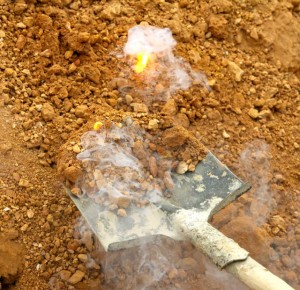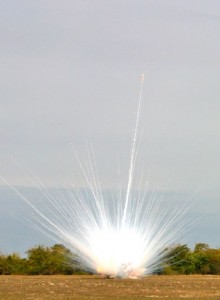Project Phongsali 2011: Man tries to open rocket, then wisely decides it’s not such a good idea after all.
Week Five
Day Thirty-One:
Yesterday a Khamu villager showed us several pieces of ordnance that he found in his rice field, carried home, and showed around the village, asking family, friends and neighbors if they thought the items could be safely opened. (They were an assortment of rockets and mortars). His hope was that the devises might contain something valuable within, perhaps precious metals or sophisticated electronic components. If they yielded nothing valuable he could, at least, sell the casings for the price of scrap.
The fellow dinked around with one of the items: an American 2.75-inch rocket that commonly contains a sizable measure of high explosive. After sawing on the rocket’s casing for a while in an attempt to cut it open, he eventually yielded either to someone’s warning or to his own doubt; he changed his mind, stopped sawing, and set the rocket aside. Fortunately, in this case, experience triumphed over hope!
Yesterday, when Vilasak, our Team Leader, inspected that rocket he could not determine exactly which model he had in hand. Was it, as the villager first guessed, a rocket containing high explosive? Or, was it a look-alike rocket filled with white phosphorous? There were no external markings visible on the corroded casing. No way for Vilasak to know for certain.
White phosphorous demands respect. Phosphorous ignites when exposed to the air and is tough to extinguish except by completely depriving it of oxygen. I’m told that a teaspoon of the stuff dropped on the palm will burn clean through a hand, consuming flesh and bone. I’ve seen hideous wartime photographs of victims burned by phosphorous; the victim must have suffered monstrous pain.
Buried within a WP rocket is a stick of high explosive that, by exploding, maximizes dispersement of the molten chemical. On occasion, we unearth highly corroded canisters containing white phosphorous that begin emitting faint wisps of smoke as soon as they’re exposed to the air. Typically, those items will slowly smolder, all the while melting more of the rusted container, allowing the phosphorous more contact with the air.
Eventually, if no one intervenes, the full charge will ignite, the stick of high explosive will detonate, and flaming streams of phosphorous will jet in every direction. Viewed from a safe location, the tendrils of burning phosphorous are an exquisite bouquet. From close up, to a burn victim, an acquaintance with hell.
Once, a teammate came across a smoking WP rocket that was drawing a crowd of curious onlookers. Realizing that he had little chance of dispersing the crowd forming around the device, he quickly wrapped the smoldering rocket in wet rags to deprive the phosphorous of air. That bought him time. He then found a deep bucket, filled it with a slurry of mud and submerged the rocket to extinguish the burn.
Yesterday, Vilasak had a hunch that the rocket we had in hand, like most 2.75’s that we find, was filled with high explosive. Therefore, when he conducted the demolition he set his blocks of TNT on top of the device. That technique drives fragmentation from the rocket casing down into the ground; better frag in the soil than flying through the air.
Vilasak played the percentages, but guessed wrong. The rocket contained white phosphorous. Had Vilasak known, he likely would have placed the TNT under the rocket, a maneuver that would have pitched the phosphorous into the sky where most of it would have burnt away and very little would have fallen back to earth.

Because our demolition pounded white phosphorous into the ground, we had to use a shovel and pitch contaminated soil into the air. When the WP hit the air it burst into flame.
As a consequence of our pounding the phosphorous into the ground, we had to observe from a distance for over an hour while the load consumed itself. (We gave what remained of the rocket a wide berth just in case the internal stick of high explosive survived the blast and was thinking about detonating).
Then, for the better part of another hour we took turns digging at the demolition site with a shovel. As we pitched dirt into the air clumps of phosphorous hidden in the soil would catch air, ignite, and burn. We had to keep at the task until we were certain that every last measure of phosphorous was destroyed.



Truly amazing!